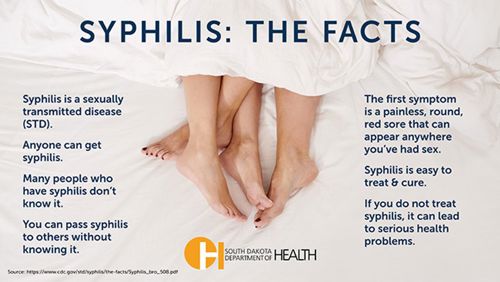
Syphilis is a bacterial infection, primarily a sexually transmitted disease (STD).
STI Testing Sites STI Control Resources for Healthcare Providers
Disease Facts
Any sexually active person can be infected with syphilis, although there is a greater incidence among young people between the ages of 15 and 30 years. It is more prevalent in urban than rural areas and in males than in females. There is also a high prevalence among men who have sex with men.
Syphilis is spread by sexual contact with an infected individual, with the exception of congenital syphilis, which is spread from mother to fetus. Transmission by sexual contact requires exposure to moist lesions of skin or mucous membranes.
 |
Primary Stage:Sores appear at the infection site but often go unnoticed. |
 |
Secondary Stage:Rashes and flu-like symptoms may develop, and then disappear even without treatment. |
 |
Latent Stage:The infection hides in your body, causing no symptoms for years. |
 |
Tertiary Stage:Serious complications arise, including damage to the heart, brain, and other organs, leading to blindness, paralysis, or even death. |
Syphilis Testing
Detailed Descriptions of Syphilis Stages
The first sign of syphilis is usually a sore(s) which is painless and appears at the site of initial contact. It may be accompanied by swollen glands, which develop within a week after the appearance of the initial sore. The sore will last from three to six weeks and will disappear by itself even if no treatment is received.
Approximately six weeks after the sore first appears, a person will enter the second stage of the disease. The most common symptom during this stage is a rash which may appear on any part of the body: trunk arms, legs, palms, soles, etc. Other, more generalized symptoms may also occur. These include tiredness, fever, sore throat, headaches, hoarseness, loss of appetite and swollen glands. These signs and symptoms will last two to six weeks and will disappear in the absence of adequate treatment.
After the second stage of the disease, the only way syphilis can be detected is through a blood test, although secondary symptoms may occasionally recur. Late syphilis (syphilis of over four years' duration) may involve illness in the skin, bones, central nervous system, and heart may impair health, and may shorten life.
Symptoms can appear from 10 to 90 days after a person becomes infected, but usually within three weeks.
Syphilis is considered to be communicable for a period of up to four years after infection. The extent of communicability depends on the existence of infectious lesions (sores) which may or may not be visible.
There is no natural immunity to syphilis and past infection offers no protection to the patient.
Syphilis is easily treated with antibiotics. The amount and type of treatment depends on the state of syphilis the patient is in. Treatment will kill the syphilis bacteria and prevent further damage, but it will not repair the damage already done.
Untreated syphilis can lead to destruction of soft tissue and bone, heart failure, insanity, blindness and a variety of other conditions which may be mild to incapacitating.
There are a number of ways to prevent the spread of syphilis:
- Limit your number of sex partners.
- Use a condom.
- If you think you are infected, avoid any sexual contact and visit your local STD clinic, a hospital or your doctor.
- Notify all sexual contacts immediately so they can obtain examination and treatment.
- All pregnant women should receive at least one prenatal blood test for syphilis.
Reducing Syphilis, 2024
Adult Syphilis: 1,504 cases reported - 90% increase from 2021 and 2,493% increase from the 5-year median. Congenital Syphilis: 40 Congenital and 3 Syphilitic Stillbirths. 150% increase from 2021 and 1,233% increase in 5-year median.

